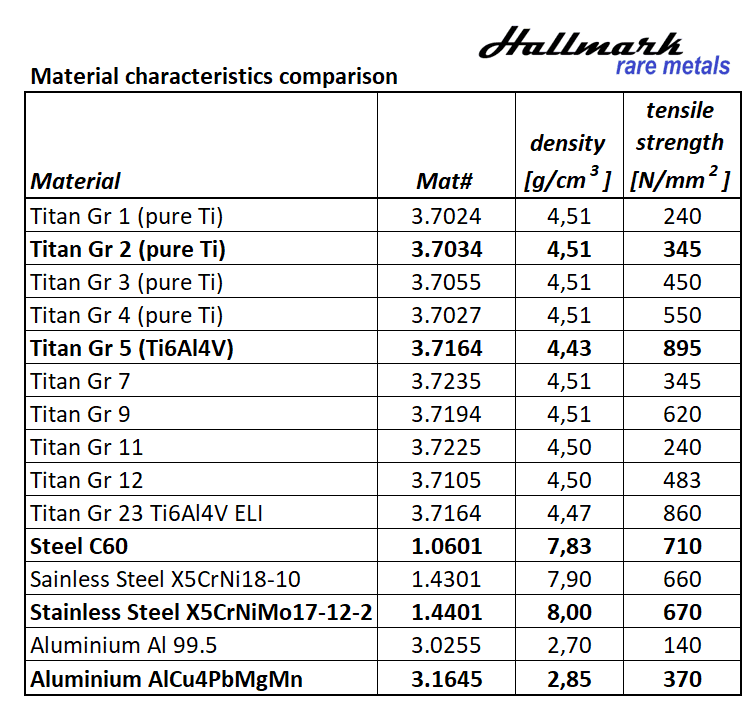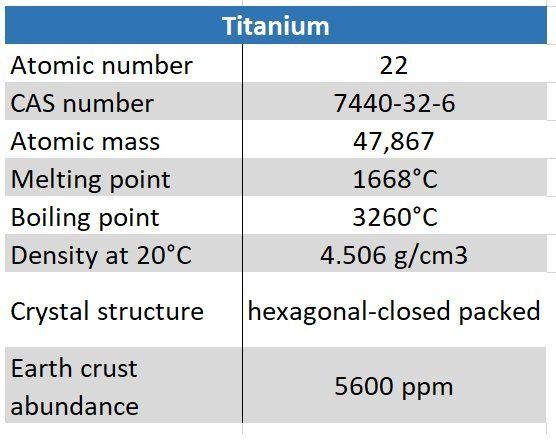Grade 1
is the most ductile and softest titanium alloy. It is a good solution for cold forming and corrosive environments.ASTM/ ASME SB-265 provides the standards for commercially pure titanium sheet and plate.
Grade 2
Unalloyed titanium, standard oxygen.
Grade 2H
Unalloyed titanium (Grade 2 with 58 ksi minimum UTS).
Grade 3
Unalloyed titanium, medium oxygen.
Grades 1-4 are unalloyed and considered commercially pure or "CP". Generally the tensile and yield strength goes up with grade number for these "pure" grades. The difference in their physical properties is primarily due to the quantity of interstitial elements. They are used for corrosion resistance applications where cost, ease of fabrication, and welding are important.
Grade 5 also known as Ti6Al4V, Ti-6Al-4V or Ti 6-4
is the most commonly used alloy. It has a chemical composition of 6% aluminum, 4% vanadium, 0.25% (maximum) iron, 0.2% (maximum) oxygen, and the remainder titanium. It is significantly stronger than commercially pure titanium while having the same stiffness and thermal properties (excluding thermal conductivity, which is about 60% lower in Grade 5 Ti than in CP Ti). Among its many advantages, it is heat treatable. This grade is an excellent combination of strength, corrosion resistance, weld and fabricability.
This alpha-beta alloy is the workhorse alloy of the titanium industry. The alloy is fully heat treatable in section sizes up to 15 mm and is used up to approximately 400 °C (750 °F). Since it is the most commonly used alloy – over 70% of all alloy grades melted are a sub-grade of Ti6Al4V, its uses span many aerospace airframe and engine component uses and also major non-aerospace applications in the marine, offshore and power generation industries in particular.
Applications: Blades, discs, rings, airframes, fasteners, components. Vessels, cases, hubs, forgings. Biomedical implants.
Generally, Ti-6Al-4V is used in applications up to 400 degrees Celsius. It has a density of roughly 4420 kg/m3, Young's modulus of 120 GPa, and tensile strength of 1000 MPa. By comparison, annealed type 316 stainless steel has a density of 8000 kg/m3, modulus of 193 GPa, and tensile strength of 570 MPa. Tempered 6061 aluminum alloy has a density of 2700 kg/m3, modulus of 69 GPa, and tensile strength of 310 MPa, respectively.
Ti-6Al-4V standard specifications include:
UNS: R56400,
AMS: 4911, 4920, 4928, 4934-4935, 4965, 4967, 6930-6931, T9046
ASTM: B265, B348, B381 F136
MIL: T9046-T9047
MMS: 1217, 1233
DMS: 1570, 1583, 1592, 2285, 2442 R-1
BMS: 7-348
Grade 6
contains 5% aluminium and 2.5% tin. It is also known as Ti-5Al-2.5Sn. This alloy is used in airframes and jet engines due to its good weldability, stability and strength at elevated temperatures.
Grade 7
contains 0.12 to 0.25% palladium. This grade is similar to Grade 2. The small quantity of palladium added gives it enhanced crevice corrosion resistance at low temperatures and high pH.
Grade 7H
is identical to Grade 7 with enhanced corrosion resistance.
Grade 9
contains 3.0% aluminium and 2.5% vanadium. This grade is a compromise between the ease of welding and manufacturing of the "pure" grades and the high strength of Grade 5. It is commonly used in aircraft tubing for hydraulics and in athletic equipment.
Grade 11
contains 0.12 to 0.25% palladium. This grade has enhanced corrosion resistance.
Grade 12
contains 0.3% molybdenum and 0.8% nickel.[
Grades 13, 14, and 15
all contain 0.5% nickel and 0.05% ruthenium.
Grade 16
contains 0.04 to 0.08% palladium. This grade has enhanced corrosion resistance.
Grade 16H
contains 0.04 to 0.08% palladium.
Grade 17
contains 0.04 to 0.08% palladium. This grade has enhanced corrosion resistance.
Grade 18
contains 3% aluminium, 2.5% vanadium and 0.04 to 0.08% palladium. This grade is identical to Grade 9 in terms of mechanical characteristics. The added palladium gives it increased corrosion resistance.
Grade 19
contains 3% aluminium, 8% vanadium, 6% chromium, 4% zirconium, and 4% molybdenum.
Grade 20
contains 3% aluminium, 8% vanadium, 6% chromium, 4% zirconium, 4% molybdenum and 0.04% to 0.08% palladium.
Grade 21
contains 15% molybdenum, 3% aluminium, 2.7% niobium, and 0.25% silicon.
Grade 23
contains 6% aluminium, 4% vanadium, 0.13% (maximum) Oxygen. Improved ductility and fracture toughness with some reduction in strength.
Grade 24
contains 6% aluminium, 4% vanadium and 0.04% to 0.08% palladium.
Grade 25
contains 6% aluminium, 4% vanadium and 0.3% to 0.8% nickel and 0.04% to 0.08% palladium.
Grades 26, 26H, and 27
all contain 0.08 to 0.14% ruthenium.
Grade 28
contains 3% aluminium, 2.5% vanadium and 0.08 to 0.14% ruthenium.
Grade 29
contains 6% aluminium, 4% vanadium and 0.08 to 0.14% ruthenium.
Grades 30 and 31
contain 0.3% cobalt and 0.05% palladium.
Grade 32
contains 5% aluminium, 1% tin, 1% zirconium, 1% vanadium, and 0.8% molybdenum.
Grades 33 and 34
contain 0.4% nickel, 0.015% palladium, 0.025% ruthenium, and 0.15% chromium .
Grade 35
contains 4.5% aluminium, 2% molybdenum, 1.6% vanadium, 0.5% iron, and 0.3% silicon.
Grade 36
contains 45% niobium.
Grade 37
contains 1.5% aluminium.
Grade 38
contains 4% aluminium, 2.5% vanadium, and 1.5% iron. This grade was developed in the 1990s for use as an armor plating. The iron reduces the amount of Vanadium needed as a beta stabilizer. Its mechanical properties are very similar to Grade 5, but has good cold workability similar to grade 9.
Titanium Welding
Welding conditions are “excellent” with the following Ti Grades: 1, 2 ,3 ,4 ,7 , 9 , 11, 12, 13, 14, 15, 16, 17, 18, 26, 27, 18
For the Grades 5, 23, 24, 29 the welding conditions are “satisfactory”
Possible welding processes are Arc, TIG, MIG, PAW as well as Resistance, friction, explosion and forging welding and others.




